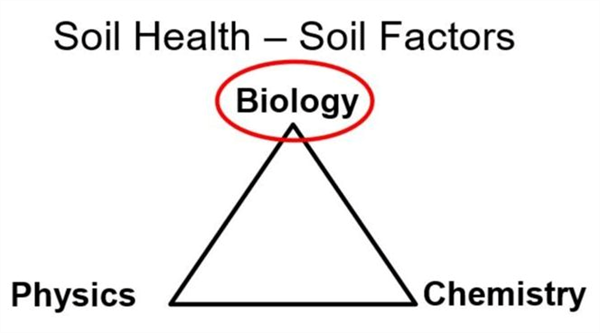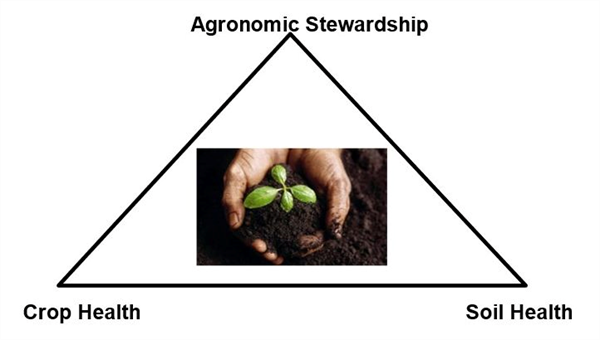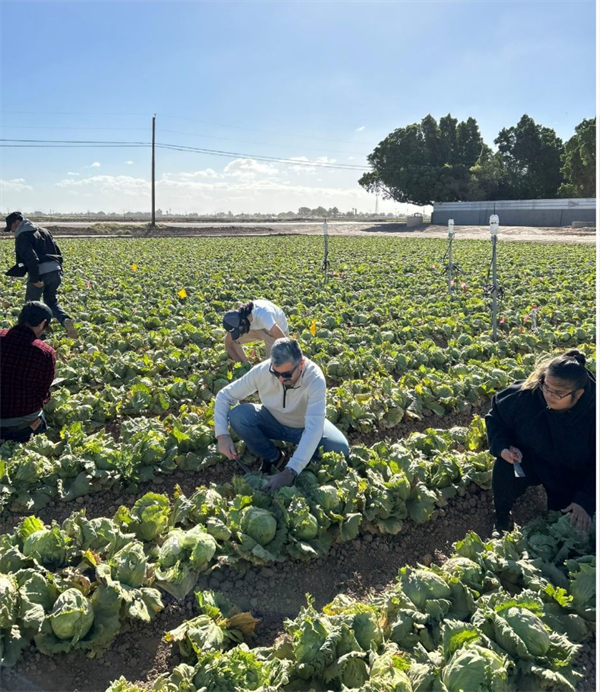
Soil is a natural component of terrestrial ecosystems, both native and agricultural. Soils are the foundation of plant and crop production systems (Brady and Weil, 2008; Parikh and James, 2012).
In terms of soil health, a good way to consider a soil system is from the standpoint of three main categories (physics, chemistry, and biology) that are fundamentally important with healthy soil function (Figure 1).

Figure 1. Soil health factors and chemical properties.
It is estimated that soil contains at least a quarter of the biological diversity (aka biodiversity) on our planet. Soils are second only to the oceans in terms of biological diversity. Billions of earthworms, nematodes, insects, fungi, bacteria, actinomycetes, viruses, and other invertebrates exist in soil naturally. These creatures produce and consume the organic material (i.e., crop residues) found in soil as part of their basic fund and collectively work to break down the organic materials that come from their bodies and plant materials into minerals and nutrients that are cycled in the soil system and support healthy conditions in the soil environment, including plant nutrients.
During the 20th century, soil scientists began to better understand the complexity of soil biology and ecology. From that work, many drugs and vaccines have been derived soil organisms. For example, antibiotics such as penicillin have been developed. Treatments for cancer such as bleomycin have come from soil and fungal infection treatments like amphotericin have also been derived from the soil microbiome. Accordingly, the biodiversity of soil still has a huge potential to provide new drugs that can help us in combating other illnesses and dealing with pathogenic and resistant microorganisms.
This tremendous biological diversity creates the foundation for the entire soil ecosystem. Soil ecosystems impact the growth of plants and animals in natural and agricultural systems. The biological composition of soils has a very strong influence on soil health.
During the 20th century soil scientists had an appreciation for the rich biological diversity in soil but they were limited in their analytical capacities (Waksman, 1936). In the past 40-50 years, soil scientists have employed an increasing level of new analytical tools that have allowed the discovery and better understanding of the number and diversity that naturally exists in soil (Sutton and Sposito, 2005).
A good description of biological diversity and its tremendous complexity can be demonstrated by consideration of the common composition of soil and the abundance of a few classes of microorganisms in one gram of soil (Figure 2).

Figure 2. Natural abundance of bacterial, actinomycetes, and fungal organisms in one
gram of soil.
It is incredible to realize that in one gram of soil there commonly exists nearly one billion individual bacterial organisms, more than a million actinomycetes organisms, and one million fungal organisms. All these organisms naturally exist in soil and these population numbers represent just one gram of soil!
Among the approximately one billion individuals in one gram of soil, there are commonly more than 10,000 different species. Soil biologists are now working to better identify individual organisms and understand their functions individually and how they function in the complexity of the soil ecosystem. We do not know all the species. Accordingly, we do not know how all these organisms are forming and functioning as a complex ecosystem. Soil ecology is a huge and rapidly expanding area of study.
We do know that soil biology and ecology are very important aspects of soil health (Figure 1). We also know that our management in the field, agronomic stewardship, has a strong influence on soil health and accordingly crop health.
Gaining a better understanding of soil health requires a better understanding of soil biodiversity and the functioning of soil ecosystems. It would be misleading to say that we have a solid understanding of the soil ecosystem function and all the managerial relationships. However, it is important to understand that working on this frontier of soil science and agriculture is critical to our efforts to maintain sustainable and productive agricultural systems for the future.

Figure 3. Interrelationship of agronomic stewardship, soil health, and crop health.
This study was conducted at the Yuma Valley Agricultural Center. The soil was a silty clay loam (7-56-37 sand-silt-clay, pH 7.2, O.M. 0.7%). Spinach ‘Meerkat’ was seeded, then sprinkler-irrigated to germinate seed Jan 13, 2025 on beds with 84 in. between bed centers and containing 30 lines of seed per bed. All irrigation water was supplied by sprinkler irrigation. Treatments were replicated four times in a randomized complete block design. Replicate plots consisted of 15 ft lengths of bed separated by 3 ft lengths of nontreated bed. Treatments were applied with a CO2 backpack sprayer that delivered 50 gal/acre at 40 psi to flat-fan nozzles.

Downy mildew (caused by Peronospora farinosa f. sp. spinaciae)was first observed in plots on Mar 5 and final reading was taken on March 6 and March 7, 2025. Spray date for each treatments are listed in excel file with the results.
Disease severity was recorded by determining the percentage of infected leaves present within three 1-ft2areas within each of the four replicate plots per treatment. The number of spinach leaves in a 1-ft2area of bed was approximately 144. The percentage were then changed to 1-10scale, with 1 being 10% infection and 10 being 100% infection.
The data (found in the accompanying Excel file) illustrate the degree of disease reduction obtained by applications of the various tested fungicides. Products that provided most effective control against the disease include Orondis ultra, Zampro, Stargus, Cevya, Eject .Please see table for other treatments with significant disease suppression/control. No phytotoxicity was observed in any of the treatments in this trial.
Last week, we initiated an on-farm demonstration of soil steaming of the season with our self-propelled steam applicator. The machine is designed to inject steam into the soil and raise soil temperatures to levels sufficient to kill weed seed and soil borne pathogens (roughly 150°F for > 20 minutes). After the soil cools (< ½day), the crop is planted into the disinfested soil.
In this trial, we are examining the viability of soil steaming for controlling weeds in spinach at the field scale level (plot size > 1/3rd ac). The machine performed well in that it was able to reach target soil temperatures at reasonable travel speeds (> 0.25 mph) in cold soil (roughly 50°F), provide uniform temperature distribution across the bed and form nicely shaped beds suitable for subsequent planting. Stay tuned for reports of weed control efficacy, crop yield and overall profitability as compared to the grower standard.
If you are interested in seeing the machine operate at the field scale level on a commercial farm, we are conducting additional trials this week! Please contact me for further information.
Fig. 1. On-farm demonstration of a self-propelled steam applicator for weed and
diseasecontrol video. We are conducting additional trials this week. Contact me if
you are interested in seeing it.
Acknowledgements
This project is sponsored and funded in part by the Arizona Specialty Crop Block Grant Program and the Propane Education and Research Council (PERC). We greatly appreciate their support.
Wanted to share the following weed germination calendars now that the season has begun. Some summer weeds withstand part of the winter and some winter annuals the summer, so these charts are general guidelines. We hope this helps for making management decisions in your operation.
Preliminary results from a field trial that is being conducted at the Yuma Agricultural Center experimental farm to evaluate seven bioinsecticides against whiteflies in broccoli demonstrate that M-Pede (Potassium salts of fatty acids aka insecticidal soap), BotaniGard 22WP (Beauveria bassiana Strain GHA), Pyganic (Pyrethrins), Surround (Kaolin clay), and Venerate (Burkholderiaspp. Strain A396) may favor measurable control of the pest. These insecticides exhibited a reduction in whitefly adults and nymphs density relative to the nontreated control (Figure 1). The trial is ongoing, and more data will be collected to assess the efficacy of these insecticides further. Potassium salts of fatty acids are produced by adding potassium hydroxide to fatty acids found in animal fats and in plant oils. Pyrethrins is a mixture of six active compounds extracted from Chrysanthemum cinerariifolium plants. Beauveria bassiana is a naturally occurring entomopathogenic fungus. Burkholderia spp. strain A396 is a naturally occurring entomopathogenic bacteria. Kaolin clay is a soft, white, naturally occurring clay mineral.

Figure 1. Means whitefly adults (A), small whitefly nymphs (B), large whitefly nymphs (C),
and total whitefly nymphs (D) as affected by bioinsecticide applications. Bars with the
same letters are not statistically significant.
In regions like Yuma, AZ, extensive farming practices, irrigation and nitrogen (N) fertilizer management should be considered simultaneously due to the important fact that N moves in the soil with water and both variables should be managed together to enhance production efficiency. Coupled irrigation and N management strategies with the efficient irrigation method can lead to a critical approach to increase irrigation and nitrogen use efficiency (NUE) while maintaining crop yield and soil productivity and minimizing the potential for N leaching or losing. The mass of leached N during the growing season may be reduced by improved irrigation efficiency that can reduce drainage volume. For example, the surface/furrow irrigation system has greater irrigation depths and lower NUE than sprinkler irrigation systems. Moreover, the methodology of N application through split/timing applications can increase the NUE, especially when utilizing micro-irrigation and sprinkler irrigation systems. One of the primary objectives of the irrigation systems is to maximize the water storage in the root zone through uniform irrigation application and distribution and in the meantime to minimize water losses through deep percolation and surface run-off. In addition, irrigation systems have been utilized to apply fertilizers (fertigation) throughout the season. Generally, these systems provide a way to supply adequate N (allows small dosage application) to the crop in-season and those systems can deliver the desired nutrition amount to the crop at any crop stage with a high efficiency and distribution uniformity. In other words, a given irrigation system has the potential to reduce the fertilizer inputs and the production costs, reduce foliar disease, and minimize leaf wetness as well as reduce the weeds.
The three most commonly used irrigation methods/systems are (i) surface (gravity), (ii) sprinkler (including center pivot), and (iii) micro-irrigation. For each of the methods, there a different management processes and the uniformity of water applications as well as infiltration dynamics, which influence the efficiency of the system as well as the efficiency of N applications. Worldwide, low NUE is one of the most important challenges for researchers, farmers, and agencies, and it is on average quite low in both organic and conventional agricultural systems, including in developed nations. It is reported that globally, pre-plant N is most commonly applied, which may lead to poor synchrony between N and crop demand, contributing to low NUE. Applying N at a uniform rate is another factor of low NUE, because the available N level for crop uptake may vary between the fields and within a given field due to the spatial variability in soil characteristics and temporal characteristics due to environmental factors.
Timing nitrogen applications for lettuce is key to maximizing nutrient management efficiency, though it can be challenging if growers are constrained by time. To minimize nutrient loss, it's best to avoid pre-plant nitrogen applications, especially in the fall. At planting, apply a starter fertilizer, positioning it below and to the side of the seed row. The first sidedress application should occur after thinning at the 2-4 leaf stage, but only if soil nitrate-nitrogen is below the critical level. A second application is recommended a few weeks later at the cupping stage, contingent on soil nitrate levels. These applications should be carefully timed and adapted based on soil conditions to ensure effectiveness. Aligning nitrogen applications with the crop’s demand not only enhances nitrogen use efficiency but also helps in managing tight schedules, reduces environmental impacts, and optimizes lettuce yield and quality (Figure 1).

Figure 1: Harvesting in the Organic/Conventional Lettuce Production Field at the Valley
Research Center, University of Arizona Yuma Agricultural Center, Yuma, Arizona.
Results of pheromone and sticky trap catches can be viewed here.
Corn earworm: CEW moth counts down in all traps over the last month; about average for December.
Beet armyworm: Moth trap counts decreased in all areas in the last 2 weeks but appear to remain active in some areas, and average for this time of the year.
Cabbage looper: Moths increased in the past 2 weeks, and average for this time of the season.
Diamondback moth: Adults increased in several locations last, particularly in the Yuma Valley most traps. Below average for December.
Whitefly: Adult movement remains low in all areas, consistent with previous years
Thrips: Thrips adult movement continues to decline, overall activity below average for December.
Aphids: Winged aphids still actively moving but declined movement in the last 2 weeks. About average for December.
Leafminers: Adult activity down in most locations, below average for this time of season.